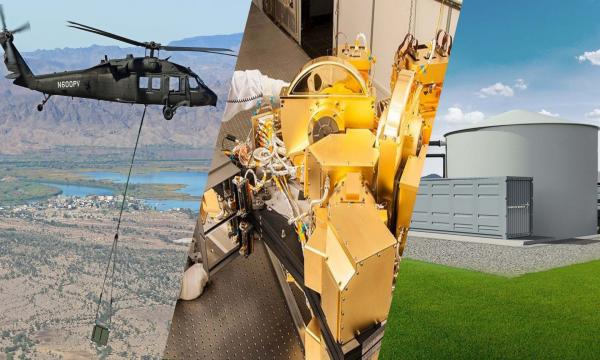Releases
BETHESDA, Md., Nov. 30, 2022 – Lockheed Martin’s (NYSE: LMT) GridStar® Flow system for long-duration energy storage, Optionally Piloted Black Hawk® helicopter and NASA's James Webb Space Telescope – with a Lockheed Martin-built main camera – have been selected by the editors of Popular Science magazine for their 2022 “Best of What’s New” Awards.
Each year, Popular Science reviews thousands of new products and innovations to choose the top 100 winners across 10 categories that represent significant progress in their fields.
GridStar Flow: Expanding Clean Energy
Selected for the Emergency Services and Defense category, GridStar Flow is a long-duration energy storage solution designed to advance clean energy goals, grid resilience, energy affordability, and sustainability for utility, commercial, Department of Defense (DoD) and other federal energy applications.
Why Does It Matter?
“Our team is dedicated to offering our customers a reliable, long-duration energy storage system that will ensure communities remain safe, secure and resilient,” said Tom Jarvi, GridStar Flow program director.
In June, Lockheed Martin was awarded a contract to build the first megawatt-scale, long-duration energy storage system for the DoD. Under the management of the U.S. Army Engineer Research and Development Center’s Construction Engineering Research Laboratory, the first customer-sited demonstration unit will be tested against protocols to ensure critical missions can continue in the event of a long-term power outage. Insights gained could support the deployment of future long-duration storage across all DoD services and installations.
Popular Science explored the technology that powers GridStar Flow.
Advancing Flight Safety: Optionally Piloted Black Hawk
Selected into the Aerospace category, the Optionally Piloted Black Hawk helicopter could change the way the way the U.S. Army resupplies forward forces in contested battlespace using utility helicopters that can be flown with or without pilots on board.
Why Does It Matter?
“In addition to increasing flight safety and reliability, MATRIX™ technology enables survivability in high-tempo, high-threat 21st Century Security environments where Black Hawks operate today, and next generation Future Vertical Lift aircraft could operate in the future,” said Igor Cherepinsky, director, Sikorsky Innovations.
During a series of demonstrations in 2022, Sikorsky, a Lockheed Martin company, in partnership with the Defense Advanced Research Projects Agency (DARPA), successfully demonstrated Sikorsky's MATRIX™ technology autonomy system, which forms the core of DARPA's ALIAS (Aircrew Labor In-cockpit Automation System) project. For example:
- Pilots landed the aircraft, then flipped a switch in the cockpit to give control to the flight computer.
- With no humans on board, the fully autonomous Black Hawk avoided imagined buildings while route re-planning in real time, and delivered internal and external cargo loads over long distances at 100 knots speed.
- The team showed how a ground operator with a secure radio and tablet can take control of the uncrewed helicopter, command it to release its sling load, and then land to evacuate a casualty.
See a video, story and photos about the Optionally Piloted Black Hawk helicopter’s most recent demonstration.
Pushing the Boundaries of Science with New Images of Our Universe
Popular Science also selected NASA’s James Webb Space Telescope as the “Innovation of the Year” for 2022, and the telescope is showing humankind the universe in a whole new light. Webb’s primary imager – the Near Infrared Camera, or NIRCam – was designed and built by Lockheed Martin at the company’s Advanced Technology Center in Palo Alto, California, in collaboration with the University of Arizona.
Why Does it Matter?
A first-of-its-kind camera, NIRCam was specially designed to take images with the utmost precision and stability at extreme temperatures in deep space. This instrument supports Webb in seeking light from the universe's first galaxies, investigating how those galaxies form, exploring the birth of stars, and studying planetary systems and outer planets in our own solar system.
For additional information, visit our website: www.lockheedmartin.com.
About Lockheed Martin
Headquartered in Bethesda, Maryland, Lockheed Martin Corporation is a global security and aerospace company that employs approximately 114,000 people worldwide and is principally engaged in the research, design, development, manufacture, integration and sustainment of advanced technology systems, products and services.
Please follow @LMNews on Twitter for the latest announcements and news across the corporation
Media Contacts:
Caitlin Deregla, +1817-944-3748; caitlin.e.deregla@lmco.com
Frans Jurgens, +1 203-615-8293; frans.m.jurgens@lmco.com
Lauren Duda, +1 303-324-1764; lauren.e.duda@lmco.com


